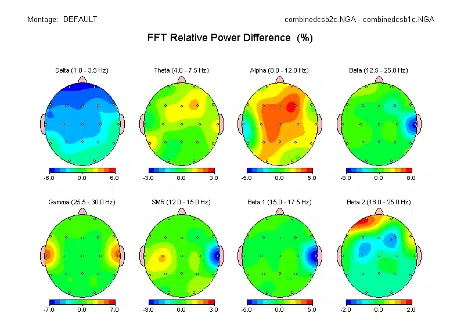Blog
Alpha Brain Waves: What Are They, And Why Are They So Important?
You may be aware that the human brain is electric. But did you know that the brain operates with five types of brainwaves?
In the brain, there are five distinct types of brainwaves, each with their own electric frequency. Each category has a different electrical frequency and plays a distinct role in how we think, behave, and feel. All of them exist at the same time in your brain, but each takes a turn being dominant at certain times.
The Five Types of Brainwaves

There are 5 distinct types of brainwaves, each with their own electric frequency Gamma waves are the fastest of the types of brainwaves; they “relate to simultaneous processing of information from different brain areas and have been associated with higher states of conscious perception.”¹
- Beta waves are the next fastest; they are low amplitude and have a frequency between 15 and 40 cycles per second. This type of brainwave is related to mentally engaged tasks, such as talking or teaching or taking part in a debate.²
- Alpha waves are slower than beta waves, but higher in amplitude. Their frequency is between 3 and 13 cycles per second. Where beta waves represent arousal, “alpha represents non-arousal. A person who has completed a task and sits down to rest…who takes time out to reflect or meditate is usually in an alpha state.”
- Theta waves are even slower, between 5 and 8 cycles per second. A person who is daydreaming or lost in thought may be in a theta state – this state is characteristic of tasks that are automatic and do not require mental effort. People who are in a theta state may say that they’re in the “flow.”
- Delta waves are the slowest of all, with only 1.5 to 4 cycles per second. Dreaming while sleeping, when accompanied by REM, would be an example of a delta state.
The Role of Alpha Waves
While each type of brainwave serves its own essential purpose, neuroscientists have found that an increase in alpha waves reduces symptoms of anxiety and depression. As explained in an article in Psychology Today, “when alpha oscillations are prominent, your sensory inputs tend to be minimized and your mind is generally clear of unwanted thoughts.”
Each type of brainwave is important; each has its essential role in our functioning properly as human beings. But when one type begins to dominate the others and the brain becomes out of balance – when our alpha waves take a backseat – we start to experience anxiety, insomnia, and depression.
Think of it this way: when you are in a state of high alertness, your brain quickly adapts to help you function at your best in the moment. Gamma waves are likely dominant in this situation, and you’re firing on all cylinders. The other types of brainwaves, including alpha, fade into the background. But this is not sustainable – at some point, you need to calm down again. If your alpha waves, the ones associated with calmness and relaxation, are out of balance and never have a chance to become dominant, your mood will likely deteriorate. Without relaxation and a sense of wellbeing, anxiety will spike, your sleep will suffer, and depression will settle in.
EEG results: there is an increase in alpha activity (relaxation brain waves) with a simultaneous decrease in delta activity (sleep brain waves) after using Alpha-Stim® for 20 minutes.
How and Why Alpha-Stim Works
Alpha-Stim M and Alpha-Stim AID devices utilize Cranial Electrotherapy Stimulation (CES) and Microcurrent Electrical Therapy (MET) that directly influence the brainwaves to relieve anxiety, insomnia, depression*, and pain.
CES is a form of non-invasive brain stimulation that applies rhythmic, low-amplitude current to the brain via earclip electrodes. Psychiatric disorders, such as anxiety and insomnia, are associated with alterations in electric activity in large-scale brain networks. Research suggests that Alpha-Stim CES technology modulates large-scale brain network activity patterns in two synergistic ways. (Learn more here).
MET is the process of directing microcurrent through the body via Smart Probes or self-adhesive AS-Trodes to treat pain. When applied peripherally, the rhythmic, low-amplitude current of Alpha-Stim MET modulates the peripheral signaling in pain circuits that emanate from the spinal cord, providing rapid, effective, and lasting pain relief with no risk of addiction or tolerance.
- Alpha-Stim AID: Microcurrent is transmitted to the brain via earclip electrodes to treat anxiety, insomnia, and depression*.
- Alpha-Stim M: Microcurrent is delivered via electrodes placed on the body at the pain site for the treatment of acute, chronic, and post-traumatic pain. Also includes earclips to treat anxiety, insomnia, and depression*.
*FDA cleared for anxiety, insomnia and pain only, with approval for depression outside of the United States.
Sources:
- https://www.psychologytoday.com/us/blog/the-athletes-way/201504/alpha-brain-waves-boost-creativity-and-reduce-depression?fbclid=IwAR37sOvM6UfTPqyY56YKTaz-SRHkH3gY4Qw_ZX8UWRfxy3qpKqXFt_n5Gqk
- https://www.scientificamerican.com/article/what-is-the-function-of-t-1997-12-22/

